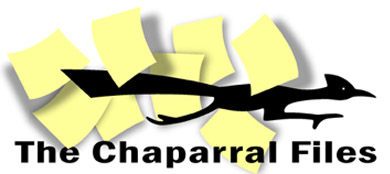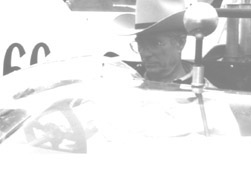Chaparral revelations
A nice challenge for The Chaparral Files!
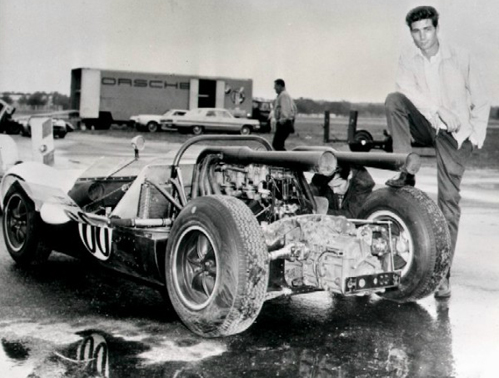
On the website www.tamsoldracecarsite.net/JimHall2.html, I spotted this picture and a riddle. The caption reads: "Ed Sauer of Seattle, WA, sent this photo of Jim Hall and an early Chaparral II. Ed thinks this was 1964. Can anyone identify the date and this rainy venue?"
Then a guess follows from a relevant person: 1960s racer & website contributor Jerry Entin: "On your picture this is the best Franz Weis (Chaparral engine builder) remembers about it. He is at the back of the car. This letter is from Franz Weis's wife Kathy."
"Franz says this photo was during the fall of 1963 when Jim was driving the first rear engined Chaparral. He's not sure where it was, but it sure was flat. Not Midland though--too many trees. Franz is down behind the car wearing his 'boys from the hood' old leather jacket. Car looks like it had been in a wreck doesn't it." Regards, Kathy Weis.
Hah! A nice challenge for The Chaparral Files! I ferreted trough the files and came to the conclusion that Ed is right for the year and I'm sorry to say that I dare to doubt Franz Weis's guess.
Let's start with some clean observations. The chassis is 2A001, to be identified by the black rollbar. The car is equipped with the Colotti gearbox as used on Hall's Chevy engined car. Although it is difficult to see, I feel the windscreen is type 1963/64, the wheels clearly are. The left front fender is damaged. So the car has experienced an excursion. Well, here's the excursion:

This photo from the book 'Chaparral Can-Am and Prototype Race Cars' of Dave Friedman tells a lot. It was taken during the USRRC Race at Riverside, April 26th , 1964. Now we compare the two pictures. The car, chassis 2A001, carries number 166. On the flank you can just see the top of the added #1. It is outside the circle. It is very possible you can't see it on the dark brown lower chassis part in the first picture because of the bad contrast between brown and black (we can see that effect also clearly on photos from Laguna Seca, the next race, when the cars carried added numbers as well; 366 and 367) and because of the angle and the door is in open position. The hay bale damaged the left front fender. Subsequently, Hall DNFd this race. To my knowledge it was the only time the number 166 was used on a 2A that crashed. A number 166 started in 1963 in Nassau but that was the Buick engined, car with the Cooper gearbox. It just retired with driveshaft trouble and had no accident.
And indeed: you would not expect the scene to be Midland/Rattlesnake (apart from the trees). With a Porsche racing transporter in the background??? And maybe it rained later that day. And no, it can't be the fall of 1963 because the cars ran with 'below deck' exhaust systems at that time.
But still there are some little uncertainties left. Although the car sports the same external horizontal exhaust pipes (which were only used for a short period of time and this was, as far as I know, the only occasion the thus equipped car crashed), the pipes seem to be chrome/light grey coloured (which they were) in the accident and blackish (which they were not) in the first picture. But maybe this is due to the ominous evening twilight and maybe to a second possibility. Although I have no reports of a fire after the crash, the rear tire seems to be covered by foam of a fire extinguisher. Could the pipes have been scorched by a fire?
All in all I would say about date/venue: USRRC Race at Riverside, April 26, 1964.
Obscure pictures: the end of the 2H's racing career
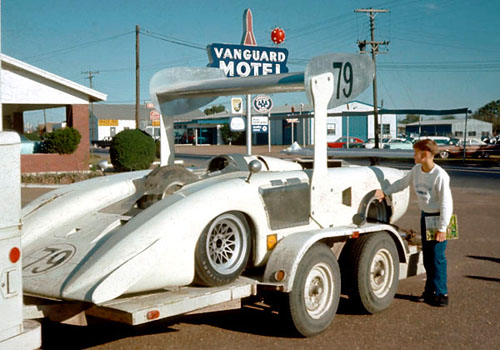
Sensational pictures these ones!!! I spotted them on www.tamsoldracecarsite.net/TomP000CanAmHomepage.html These photos were taken by one Tom Piantanida at the Texas Can-Am round of 1969. His accompanying text reads:
"Little-known substitute driver Tom Dutton (nothing in Google!) crashed the car in practice, causing this innovative car to miss its home-state Can-Am. I found the Chaparral 2H at a motel near the track. Can you believe that the most innovative entrant still brought his car to the track on an open trailer?? Actually, the car was driven by Tom Dutton - not by Jim Hall, who had been seriously injured the year before. Tom crashed the car in practice, and retired it. It was a different era when even the most innovative (and probably among the more expensive) Can-Am cars showed up on open trailers."
Mr. Piantanida: here's a little more information about the driver: according to Pete Lyons in his book 'Can-Am'; Tom Dutton campaigned his own Lola T-70 earlier in the series before joining Chaparral as a test engineer and was a stand-in for Surtees in the car's home state. He lost the car in the first hour of practice and cracked the plastic monocoque against a wall.
Now it's time to take a closer look at these marvellous pics. First of all it is clear the photos are taken after the crash. Witness the shattered front window and the damaged rear wing. The left side window is taped up. It is obvious it could not be raced this way. You would need more tape! The right 'front fender' of the body seems to be cracked also. But the car is in rather good condition, other than believed at the time. There were even reports of the car being 'totalled' or 'destroyed'. Only after more than twenty years the Falconer book revealed the truth to the world. The wheel inside the cockpit can't be a 2H racing wheel. It is far to narrow. So what is it? The spare wheel of the truck or trailer?
Another interesting detail: the racing number! The whole season the car sported a 7 (why was the car not featuring 66 anyhow?). Even the replacement Chaparral McLaren M12 sported the 7. Every car in the series carried the same number during the year. Why the 9 was added is very strange and, apart from that, little known. Only the stats in my beloved Japanese book 'Chaparral, The Texas Roadrunner' mention the 79 although without pictures. Even the position on the flanks is different compared to the rest of the season. It's on the endplates of the 'granddaddy' wing and not on the struts on the monocoque. I suspect there was not enough room on the struts for the double. The 9 could easily be an upside down leftover 6 from the year before.
Another thing: these pictures prove that the car was driven at the Texas International Speedway with the giant central wing whereas nobody, journalist nor team members, ever mentioned this fact. All the literature in my possession reports this wing was only intended for the short, twisty Laguna Seca track where downforce is needed more than straight line speed and was subsequently only raced over there. The next race at Riverside it was tried in practice but almost immediately abandoned and the car raced topless. Even more remarkable is the fact that Texas International Speedway was a new tri-oval speedway, a track where top speeds exceeded 200 mph. The original low drag concept of the 2H would be most fitting for that kind of racing. What was all this downforce and drag for?
Talking about the struts: they prevent the 'doors' from being opened! The scrutineers must have been asleep at the time..
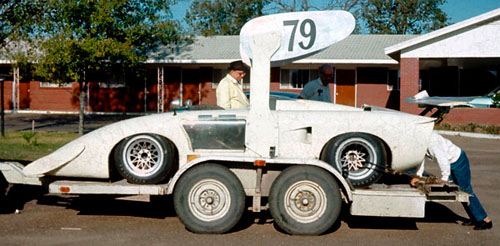
To me these pictures breathe loneliness. They strengthen my feeling that this participation was just a kind of half-hearted one-man operation. Just a weekend trip, relatively close to home. Just Tom Dutton in a pick-up truck with a trailer on a mission for his own good, permitted by Hall who was long busy doing other things. I mean, the 2H's season was virtually over, John Surtees already left, results were low, there was no hope for the white whale to finally prove competency in the finale, it was to be sidelined anyway because the next Chaparral would be a radical different concept, so what was to gain? Some start money? A sad end for a monumental car..
Tom Piantanida, whoever you are, thank you for taking these important pictures and putting them on the internet. To my knowledge, never before were photos of the 2H connected to this Can-Am round published. They truly add history!

